Stories
Sharon Ng
1961-

Sharon Ng’s preferred palette has always reflected the wide skies and soft colours of the landscapes she grew up in. Born in Totara, Oamaru, she worked alongside her family in this small South Island Chinese gardening community and influences from this childhood are evident in Sharon Ng’s long career in fashion design.
Her engagement with traditional skills of knitting and hand-sewing can be attributed directly to her mother and grandmother. "My grandmother couldn't read patterns but if someone would knit her a full cable she could repeat it," Sharon remembers. "She used to make up her own patterns. I still have a couple of pieces of clothing that she made for my mother as a young bride from China. They were all fully hand-stitched."
Sharon also recalls her mother having a sort of uniform for work – a plain day 'qipao'. She refers too, to old portraits of Chinese miners and farmers in western suits and waistcoats that had been washed. "They were sort of organic, rather than crisp."
These are all elements that have their echo in Sharon’s urban style garments. She favours comfortable workwear, the skills of crafting, and the use of natural fibres with an organic feel to them.
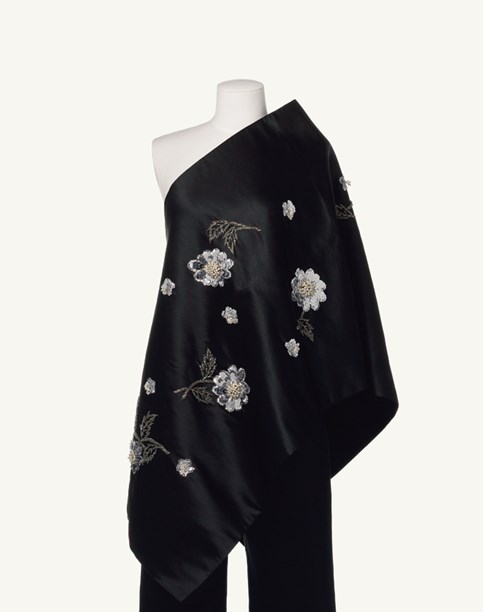
A shawl from the NG A/W 2003 collection, Chinoiserie. Photo by Michael Hall © Te Papa.
Sharon also loves beautiful and finely crafted pieces. As a girl she was fascinated by her mother’s wardrobe with its embroidered, silk sequined cheongsams, and their more casual woollen and silk versions. And the two hand-tailored suits that she never saw her mother wear. Her father too "always dressed well; the family wouldn't have had much, but whatever they had would have been good quality." Ideas for some of Sharon’s more formal designs were seeded here and she still prefers 'individual' to 'grand'.
Sharon enjoyed art classes at Waitaki High school but feels she came into her own at Wellington Polytechnic where in 1979 she studied for the two-year Diploma of Clothing and Textiles. For the first time she enjoyed education, without feeling 'different' as a negative experience. "At fashion school it was quite nice to be different," she smiles.
Impeccable tailoring has become a hallmark of her garments. This belies the fact that she struggled with machining garments, at home, in high school, and in polytech classes. A self-confessed perfectionist, she was slow but considerably consoled by a polytech tutor who said: "Never mind, when you have your own label you will have your own machinists, but it is really important to know how to sew."
After graduation she returned south to live in Christchurch with a dream to have her own label. However the need for further knowledge plus her strong work ethic, saw her embarking on a series of jobs covering practically every aspect of the fashion business.
The first of these was designing menswear for Players Male Boutique in 1981. Sharon ran the workroom and hired staff for a year. On the side she was doing pattern making jobs. She also worked for Television New Zealand’s wardrobe department, and other clothing labels including Christchurch’s Barbara Lee, designer and owner of Panache. She remembers changing her full time job every year, having a new job within a week. This variety of work gave her a thorough grounding in all the facets of the industry.
A turning point was winning the Christchurch Star award in 1982, the first competition Sharon ever entered. The encouragement of judge and fashion editor Denny Greenslade, led to the establishment of her 'Sharon Ng' label.
Aware that a career in fashion would benefit from overseas experience, Sharon took an OE to Hong Kong with plans to continue on to New York. On her first day in Hong Kong Sharon was hired by Colby Stanton Far East, a Canadian-English company that manufactured international labels. Although Sharon had come to Hong Kong to experience blending in with those around her, she found her New Zealand upbringing set her apart. Homesickness for wide skies and trees saw her back in Christchurch after only six months, canceling the rest of her trip.
Once home she embarked on her first collection. After testing her sculptural, feminine silhouettes with Christchurch fashion doyens, Pieter Stewart and Paula Ryan, Sharon began selling her merino range through select stores nationwide. One of her pieces was featured on the opening titles of Gloss, the local television series that defined 1980s fashion.
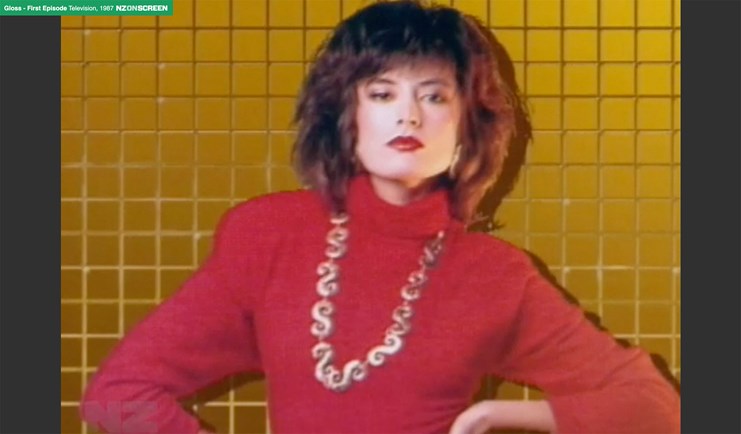
One of Sharon's designs featured on the featured on the opening titles of the 1980s tv show Gloss. Image from NZ On Screen.
When it came to sourcing fabrics as a starting out designer, Sharon says she was either quite brave or silly. "I started with buying woollen yarn for machine knitting and I garment-dyed as well because I wanted different things. I imported Irish linen to do my second summer collection; in the 1980s paying $55 dollars a metre was crazy! But it taught me to be careful with my fabric."
Throughout this time Sharon continued her part time work for other clothing companies, including pattern making for leather firm Marcol. It was Marcol’s owner, John Collingwood, who suggested she get a teaching job rather than multiple part time jobs. Always quietly spoken, Sharon didn’t think teaching was her thing. Despite her shyness she spent the next few years teaching patternmaking and design at Christchurch Polytechnic and turned working on her label into her full time job.
Sharon entered work in the Benson & Hedges Fashion Design Awards from the late 1980s with limited success, but in 1991 she won the Lifestyle Award category. "I worked on it like a design project and I won," she remembers.
Sharon Ng’s winning outfit at the 1991 Benson & Hedges Fashion Design Awards. Image © Benson & Hedges Fashion Design Awards.
Although it was a garment she cared little for as a designer, nonetheless the prestige of this win boosted her profile and gave her the confidence to set up her new label, NG in 1993. With this label she engaged her passion for craft practices and for contemporary New Zealand art. As Angela Lassig writes in New Zealand Fashion Design (Te Papa Press 2010), "her small, thoughtful collections play at the boundary between fashion design and art".
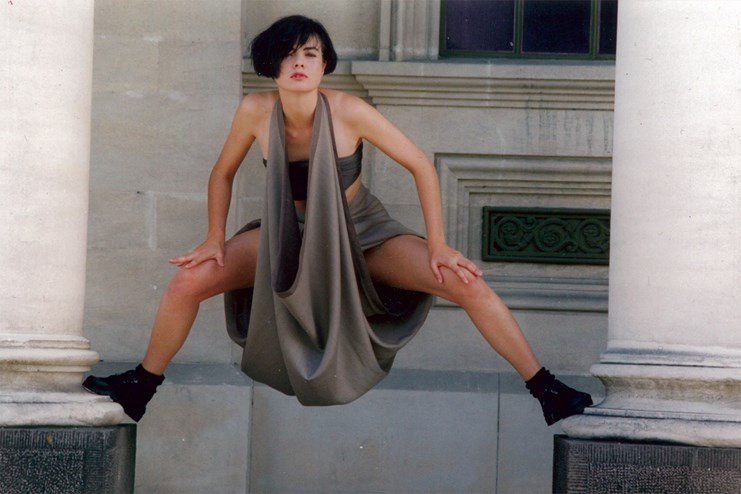
This draped garment, Sharon’s entry in the 1992 Benson & Hedges Fashion Design Awards, was highly commended in the avant-garde category. Photo by Alison Gilmore.
In the 1990s Sharon considered moving overseas again. She travelled to Japan in 1993 and London in 1996, where she was offered a place at Central St Martins College of Art and Design. Realising she would miss her home too much, she turned down the offer.
Over the years Sharon has collaborated with prominent artists including Ralph Hotere for the 1994 Benson & Hedges Fashion Design Awards, sculptor Bing Dawe in 1995, and four garments with Phillip Trusttum that featured at New Zealand Fashion Week in 2003.

Sharon collaborated with Christchurch artist Bing Dawe to design this black and white outfit. Photo by Alison Gilmore.
In 2004 her qipao (cheongsam) was decorated with artist Bill Hammond’s bird people. She has subsequently designed scarves with artists Jason Greig and Rob Hood.
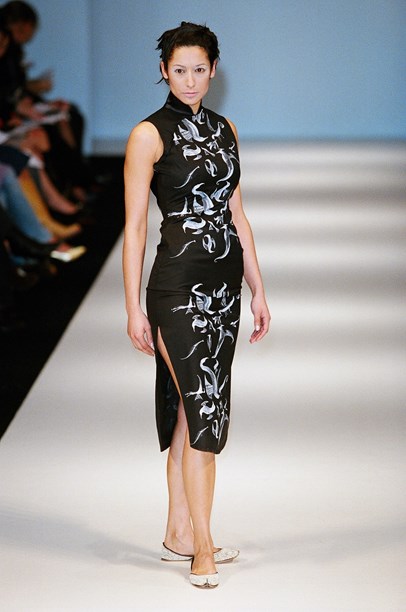
'Qipao' dress, NG in collaboration with Bill Hammond, 2004. Photo by Michael Ng. Image © Michael Ng.
High end boutiques like Victoria Black in Christchurch and Scotties in Auckland stocked her collections. These often included knitwear and in 2002 she worked with Marilyn Sainty of Scotties on a knitwear collection creating the label, NG&MS. Sharon says she valued this collaboration with a respected designer more than winning fashion awards or doing catwalk shows.

Jumper by NG&MS, NG collection show, New Zealand Fashion Week, 2001. Photo by Michael Ng.
In 1998 she and husband Roland Logan had their daughter Francesca. Sharon gave up teaching and focused on making and promoting her own collections. She started showing at Fashion Week New Zealand in 2001, doing a group show with Holic, Luna and Liz Mitchell, followed by two years of solo shows and, in 2004, another group show with Barbara Lee and Sakaguchi.
In 2005 she and Roland purchased the historic Bains building in Madras Street, and established the NG gallery, later adding a café and a boutique to sell Sharon’s label and a selection of compatible international labels and accessories.
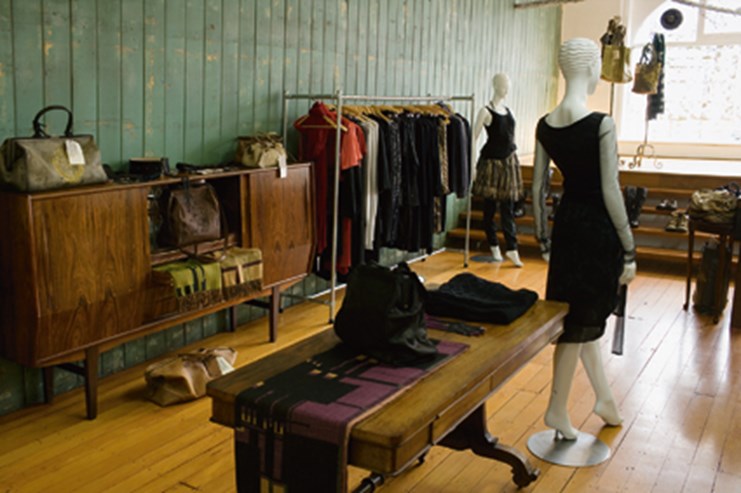
NG store interior in Christchurch, 2008. Photo by Michael Hall © Te Papa.
That year too, Sharon took part in the first of three New Zealand Trade and Enterprise-sponsored trips to promote New Zealand fashion at the fashion trade fair, Tranoi Montaigne, in Paris. These visits provided an opportunity to source new labels for her shop and to indulge her passion for fabric and adding to her collection with purchases sourced from French flea markets.
The Christchurch earthquakes of 2010 and 2011 marked an abrupt change for many. Sharon and her family were no exception and for some months after the 2011 quake she moved part of her stock to a friend’s lounge in Merivale. "I would open up during the day from 11 to about 3 – and our customers would come in and talk about what was going on for them."
Ongoing issues with the Bain’s building, their home, and personal stress took their toll. Even though NG was one of the first businesses to resume in the city, keeping up with regular collections became impossible. Sharon currently makes what she calls 'basics' beautifully cut dresses, pants and tops in silk and wool for her local and international clientele, working from her atelier above the NG gallery. "They are for people who like garments that have a certain style and point of difference," she explains. "My work is often subtle – I don't really like to stand out."

Sharon and her cat Inkling. Photo © Sharon Ng.
She still travels to Paris Fashion Week twice a year buying for her Christchurch boutique and there is always her beloved knitting. She has an especial fondness for Escorial wool which is notoriously difficult to spin. "I have been buying natural coloured Escorial - there's one spinner in Oamaru who is skilled enough to spin it for me. Eventually I will make some pieces."
The post-earthquake period, including the Covid 19 crisis, has been a time for reflection. "I think that earlier in life I always had too much on," she says. "I never had time to really look and to adjust and reflect. Now I think when I make collections again, which I do plan to, the work will be much more considered."
Text by Katherine Findlay. Banner photo of Sharon Ng by Michael Hall, image © Te Papa.
Published June 2020.